
Meet Hong Kong’s ‘Flower Granny’ artist, 92 – likened to Yayoi Kusama – for whom the world is her canvas
- Fapopo started painting at 80 and now her colourful flower and animal motifs adorn thousands of everyday objects
- Her most recent solo exhibition was held around a year ago, while a snapshot of her work is currently on show at The Park Lane Hong Kong hotel in Causeway Bay
Cocooned in warm layers, a pink beanie sealing in the heat, Fapopo – Hong Kong’s “Flower Granny” – dips a well-worn brush into a pot of paint.
A pair of black boots, owned by this writer, is about to be embellished with her signature look.
“I will paint pink flowers on them just like my shoes,” she says, pointing a brush at her own customised footwear.
At 92 years old, Fapopo – literally “flower granny” in Cantonese – is proof that you are never too old to pursue your dreams.
Fapopo, who will not disclose her real name, started painting at 80, the age she retired from selling flowers at the Mong Kok Flower Market in Kowloon, a job the flower-lover had held since her mid-twenties.
On a recent visit to Fapopo’s village home in Sai Kung district, in Hong Kong’s New Territories, it is clear that her love affair continues. “I spend my whole time thanking flowers,” she says.
After ‘Picasso of the East’ left China, his life was a mystery. Until now
It’s a cold and grey winter’s day but here, Fapopo’s colourful motifs, mostly flowers and animals, brighten the cement walls and footpaths.
What makes Fapopo’s art so special is she uses everyday household items as canvases: chairs, tables, umbrellas, irons, rice cookers, woks, a toilet seat, a vacuum cleaner, with many pieces rescued from the rubbish. At her home, painted items are scattered far and wide – and high. Some dangle from branches.
A guitar and violin, recent donations from a neighbour, have also been decorated, but her pride and joy is a toy Ferrari, the luxury car maker’s prancing horse logo almost lost in Fapopo’s hand-painted garden.
But this humble artist, who paints not to attract attention but because she genuinely loves the process, is far removed from the world of luxury.
Born in Hong Kong, Fapopo’s world is rich in colour, but she grew up poor, forced to supplement her flower-market income by collecting and selling waste boxes.
“During peak periods like Valentine’s Day and Chinese New Year, the flower business was steady but when it was quiet, Fapopo had to sell cardboard to support her family,” says Ruby Fung, owner of the 13A New Street Art Gallery in Sheung Wan.
“While collecting cardboard, she would sometimes need to rest in a public toilet.”

Fung is one of Fapopo’s biggest supporters. In January 2023, she hosted a solo exhibition of the artist’s work at her gallery.
Titled “Dancing with Flower”, it featured more than 30 pieces, with the space adapted to resemble Fapopo’s garden: some works dangled from the ceiling, others were attached to clothes hangers with pegs.
“Her work is extraordinary, considered and thoughtful, very impressive for a self-taught artist,” Fung says.
Selecting art for the show was difficult, Fung says. “After 10 years of painting she had thousands of pieces.”
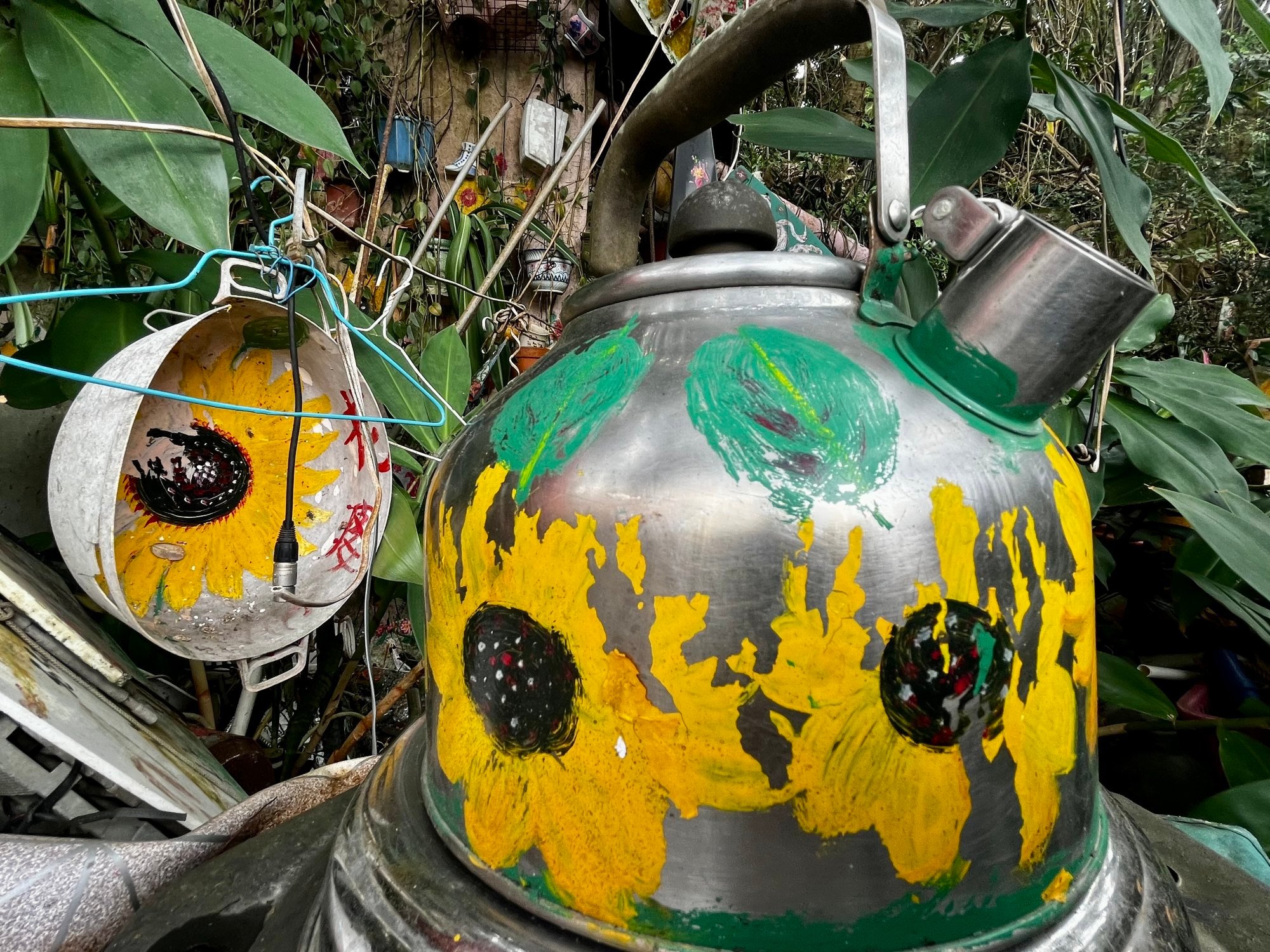
While “Dancing With Flower” was Fapopo’s biggest exhibition, it was not her first. In 2014, her art was displayed at “The World of Fapopo” at the Citywalk shopping mall in Tsuen Wan.
Those keen to see her work now can get a snapshot at “Art Beyond Boundaries”, an exhibition at The Park Lane Hong Kong hotel in Causeway Bay that runs until May 1.

The comparisons transcend age and gender. Much like Kusama, who smothers her canvases with her signature dots, Fapopo, too, is not a fan of creative white space – the front, back and even bottom of her canvases get the full Fapopo treatment.
For now, painting a pair of boots is her immediate project and it’s a challenging one: the paint is being quickly absorbed by the soft suede fabric. But in typical Fapopo fashion, she perseveres. “I will do many layers to make it thick.”
No challenge is too big for Fapopo, who perfectly embodies Hong Kong’s “can do” spirit.
“Fapopo started painting because she needed renovations done to her house but could not afford a professional painter, so she did it herself,” Fung says. “She is very strong.”

Her work also embodies “outsider art”, a swelling global movement that embraces self-taught creatives who are not connected to the conventional art world.
While flowers are Fapopo’s signature look, birds and butterflies also feature, along with roosters, rats and other animals of the Chinese zodiac.

She also loves painting faces, especially those of handsome young men, Fung laughs, holding up a portrait Fapopo did recently of a well-known Hong Kong influencer who attended the January opening of The Park Lane Hong Kong exhibition.
“For Fapopo, painting is like taking a photograph. Her hand is a camera,” Fung says.
While some faces are familiar, others are sourced from her imagination. Famous faces are also captured. On the underside of a discarded plastic tabletop is the recognisable face of the late British comic actor Charlie Chaplin.
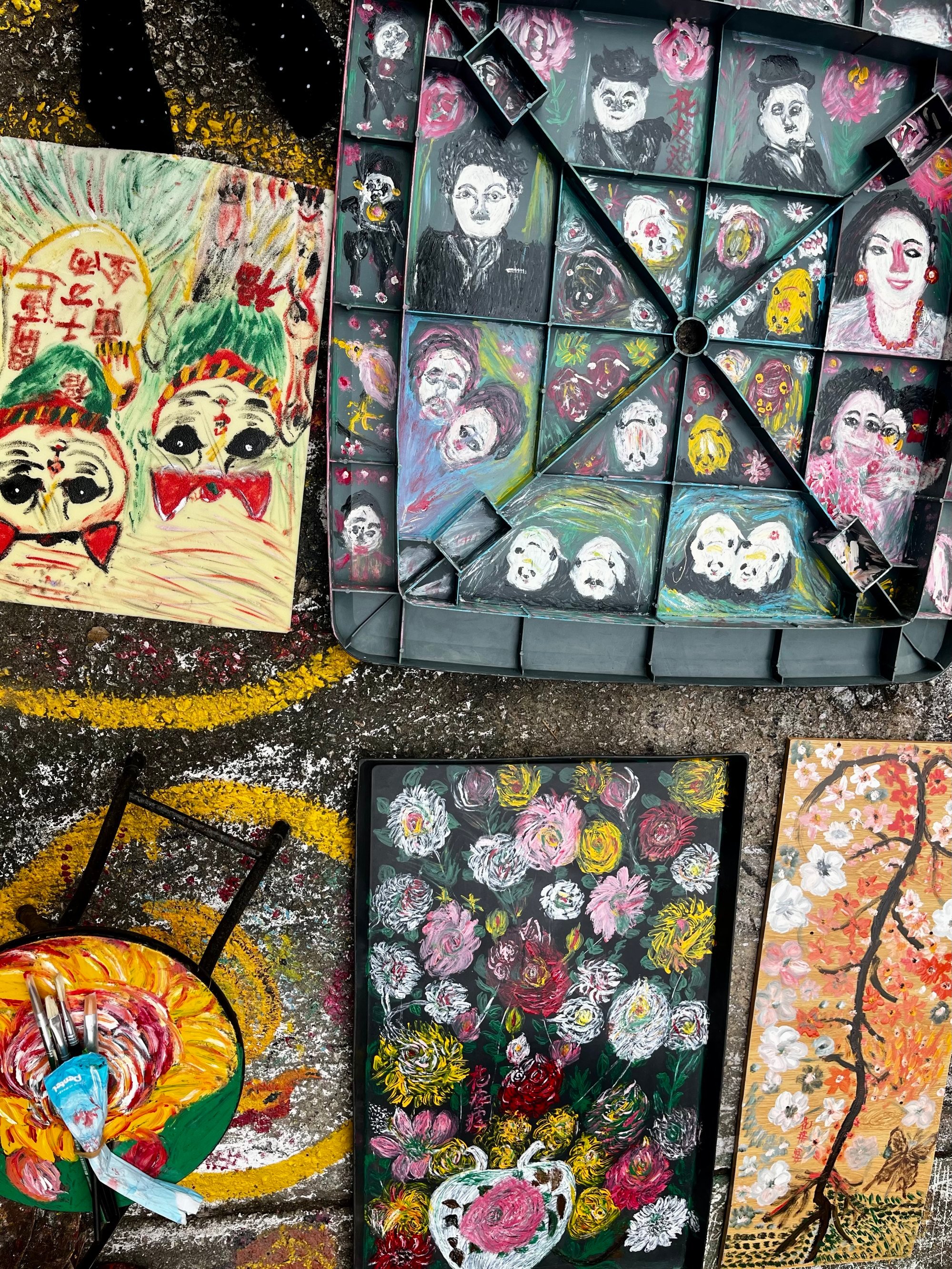
Fung points to a portrait perched high in a tree. “That is her late husband looking over the garden, as if playing the role of security guard.”
While Fapopo says flowers are like her children, she does have a son and three daughters present for this interview, who want to remain anonymous. The family bond is strong.
“None of us sisters are artists. It is my mother who is the ‘drawaholic’ in the family,” says the middle sister with a laugh.
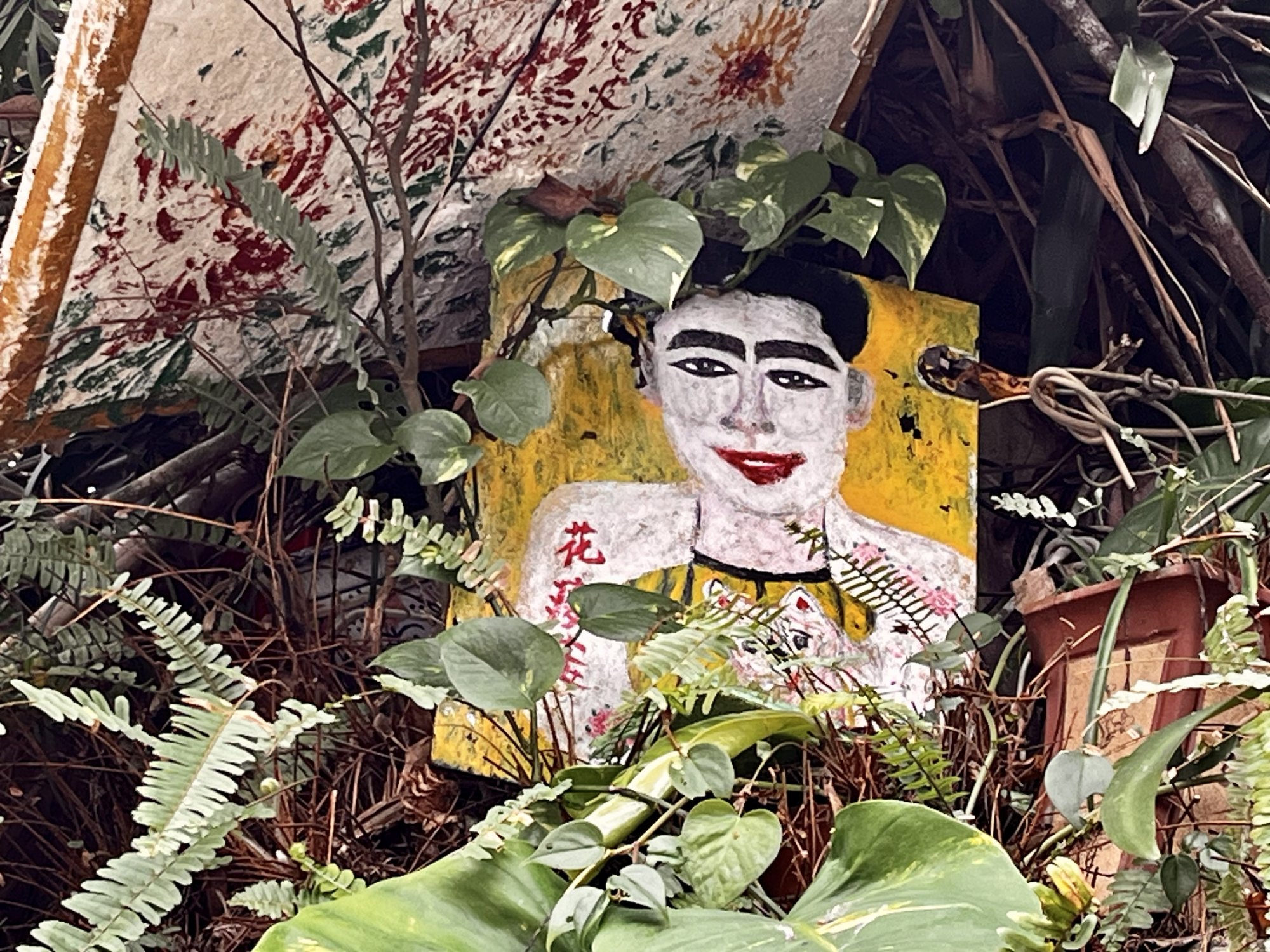
Since Fapopo took up painting, family members have taught her how to sign her artwork – she could not write Chinese before – as well as write characters for luck, good health and prosperity.
Like many of her generation, Fapopo is superstitious, a reason why maneki-neko, the waving cat that is said to bring prosperity and good fortune, is one of her favourite subjects to paint. Around Fapopo’s garden, the lucky cat is plastered on a variety of surfaces, from walls and windows to woks.

When Hong Kong was in the grip of Covid-19, Fapopo was granted permission by a village elder to paint lucky cats on the walls at the entrance to the village.
There are a lot of them but according to Fapopo, the more cats she painted, the better protected the village was from the virus.
“You can see that the waving arms of the cats are big and strong because she says the stronger the arms, the more protection they would provide,” Fung says.
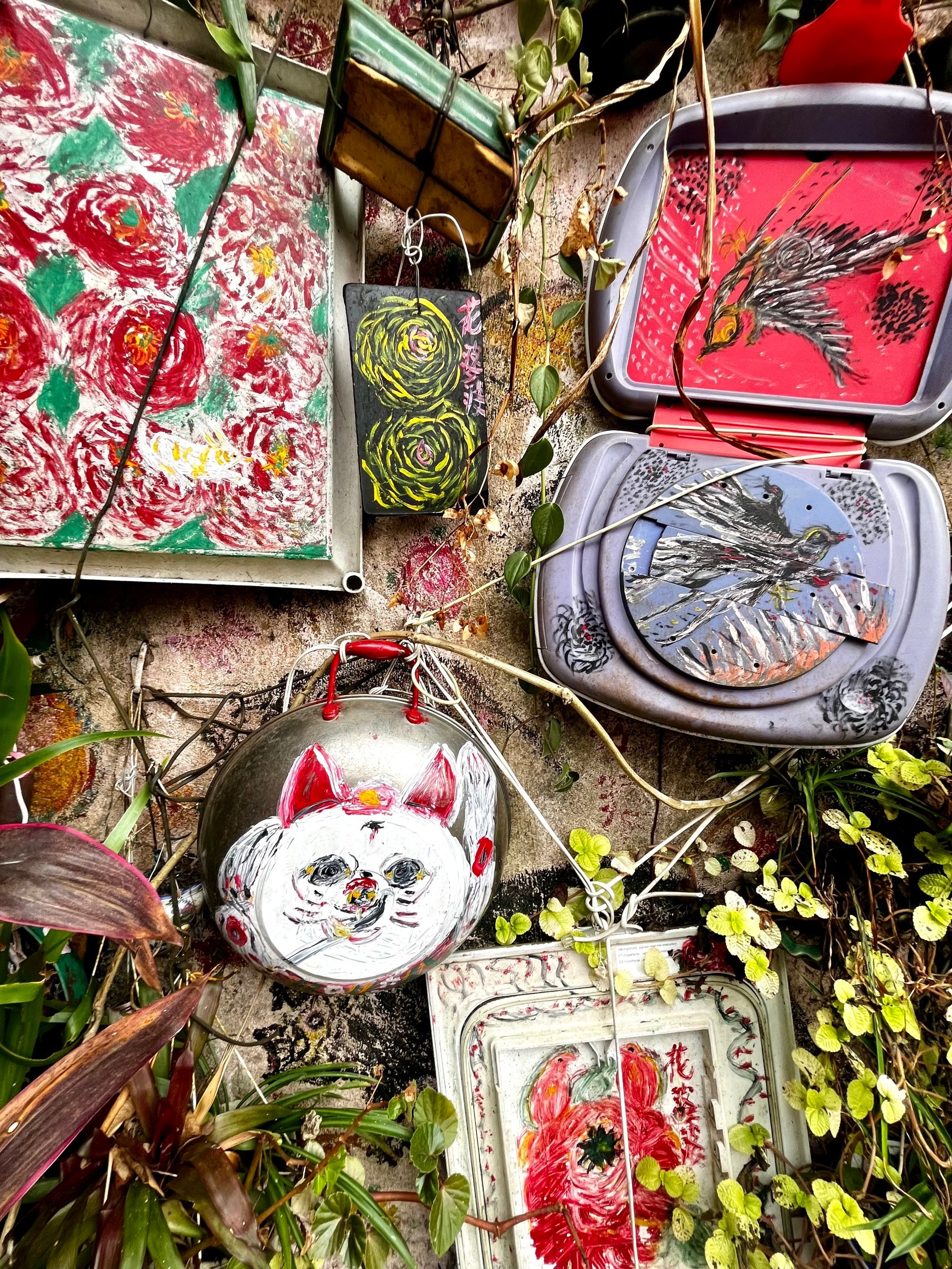

While the inside of Fapopo’s home, where much of her art is kept, is off-limits for this interview out of respect for family members living there, the garden provides enough visual stimulation to get a picture of her prolific output.
Just when you think you’ve seen everything, something new is spotted in the greenery. “I see something different with each visit,” Fung says.
To help move around, Fapopo leans on a walking stick which, of course, bursts with blooms. She says she paints every day, her love for flowers stemming from her childhood.
“I do not need any encouragement to paint,” she says. “It makes me happy.”
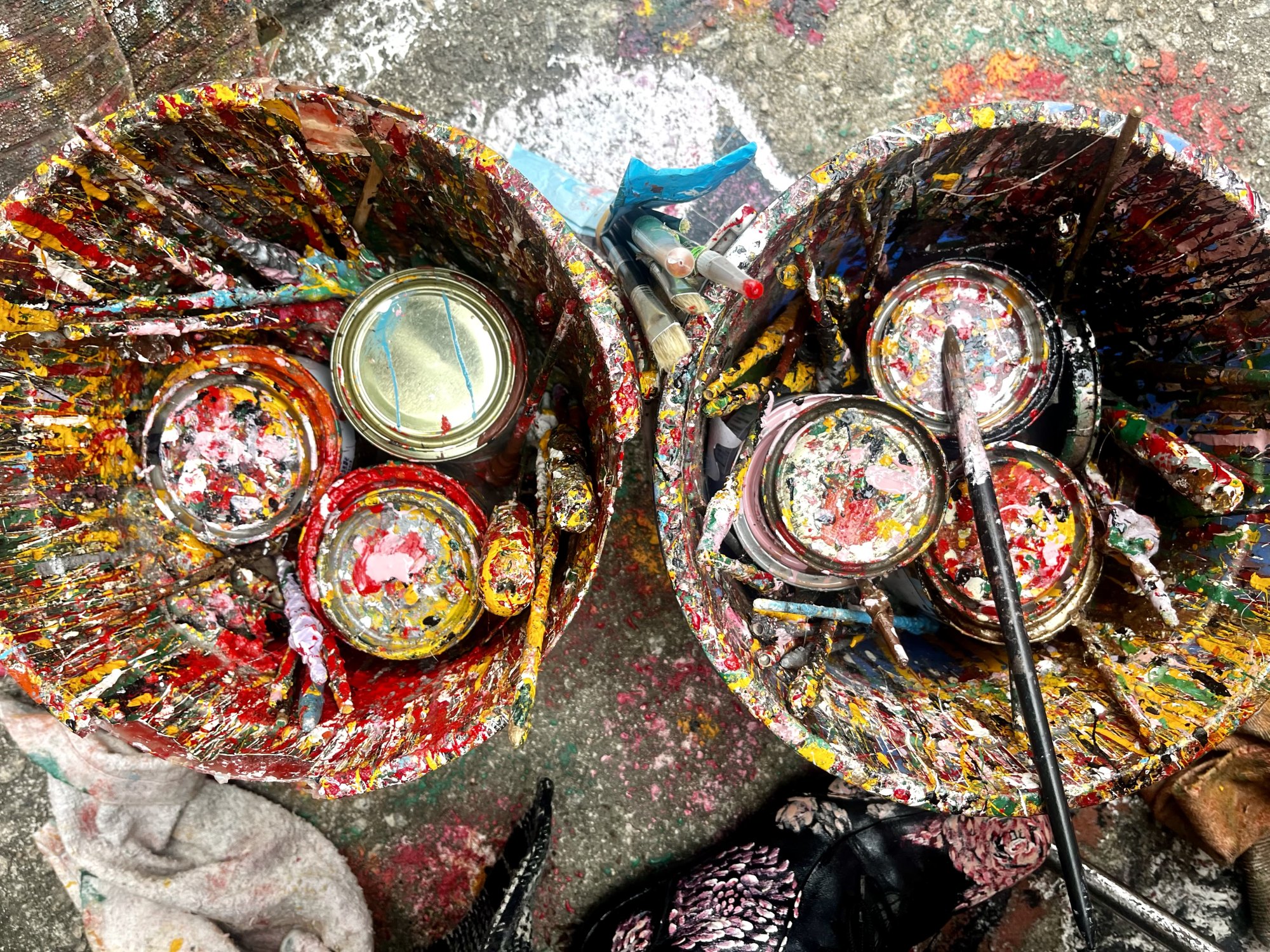
Painting also keeps Fapopo’s mind busy and hands moving, important steps in preventing ageing conditions such as arthritis and dementia.
Fapopo looks down at her hands. Fung explains that Fapopo does not like her hands.
“She wants soft, slim and smooth hands and thinks her paint-covered ones are dirty. But I tell her that it is OK to have paint on them because she has the hands of an artist.”


